人教版八年级英语下册unit1-what's-the-matter-1a-1c说课稿复习课程
- 格式:docx
- 大小:15.99 KB
- 文档页数:6
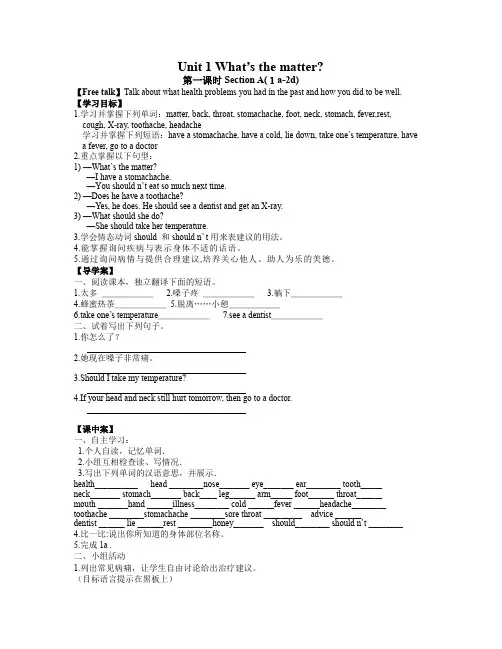
Unit 1 What’s the matter?第一课时Section A(1a-2d)【Free talk】Talk about what health problems you had in the past and how you did to be well. 【学习目标】1.学习并掌握下列单词:matter, back, throat, stomachache, foot, neck, stomach, fever,rest, cough, X-ray, toothache, headache学习并掌握下列短语:have a stomachache, have a cold, lie down, take one’s temperature, havea fever, go to a doctor2.重点掌握以下句型:1) —What’s the matter?—I have a stomachache.—You should n’t eat so much next time.2) —Does he have a toothache?—Yes, he does. He should see a dentist and get an X-ray.3) —What should she do?—She should take her temperature.3.学会情态动词should 和should n’ t用来表建议的用法。
4.能掌握询问疾病与表示身体不适的话语。
5.通过询问病情与提供合理建议,培养关心他人、助人为乐的美德。
【导学案】一、阅读课本,独立翻译下面的短语。
1.太多______2.嗓子疼______3.躺下______4.蜂蜜热茶______5.脱离……小憩______6.take one’s temperature______7.see a dentist______二、试着写出下列句子。
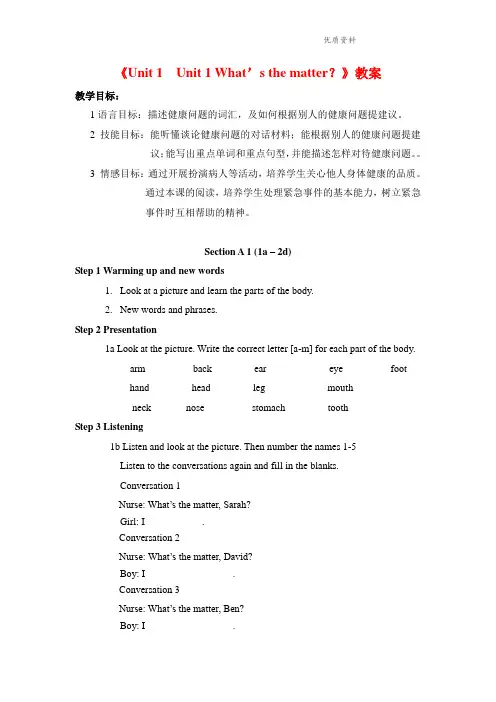
《Unit 1 Unit 1 What’s the matter?》教案教学目标:1语言目标:描述健康问题的词汇,及如何根据别人的健康问题提建议。
2 技能目标:能听懂谈论健康问题的对话材料;能根据别人的健康问题提建议;能写出重点单词和重点句型,并能描述怎样对待健康问题。
3 情感目标:通过开展扮演病人等活动,培养学生关心他人身体健康的品质。
通过本课的阅读,培养学生处理紧急事件的基本能力,树立紧急事件时互相帮助的精神。
Section A 1 (1a – 2d)Step 1 Warming up and new words1.Look at a picture and learn the parts of the body.2.New words and phrases.Step 2 Presentation1a Look at the picture. Write the correct letter [a-m] for each part of the body.___arm ___ back ___ ear ___ eye ___ foot___hand ___ head ___ leg ___ mouth___ neck ___nose ___ stomach ___ toothStep 3 Listening1b Listen and look at the picture. Then number the names 1-5Listen to the conversations again and fill in the blanks.Conversation 1Nurse: What’s the matter, Sarah?Girl: I ___________.Conversation 2Nurse: What’s the matter, David?Boy: I _________________.Conversation 3Nurse: What’s the matter, Ben?Boy: I _________________.Conversation 4Nurse: What’s the matter, Nancy?Girl: I _________________.Conversation 5Betty: What’s the matter, Judy?Ann: She __________________.Step 4 Speaking1c Look at the pictures. What are the students’ problems? Make conversati ons.ExamplesA: What’s the matter with Judy?B: She talked too much yesterday and didn’t drink enough water.She has a very sore throat now.A: What’s the matter with Sarah?B: She didn’t take care of herself on the weekend. She was p laying withher friends at the park yesterday. Then it got windy, but she didn’t puton her jacket. Now she has a cold.Step 5 Guessing gamesGuess what has happened to the students by using the important sentenc es. Step 6 Listening2a Listen and number the pictures [1-5] in the order you hear them.2b Listen again. Match the problems with the advice.Step 7 Speaking2c Make conversations using the information in 2a and 2bA: What’s the matter?B: My head feels very hot.A: Maybe you have a fever.B: What should I do?A: You should take your temperature.Step 8 Role–playImagine you are the school doctor. A few students have health problems.Role-play a conversation between the doctor and the students.2d Role –play the conversationStep 9 Language points and summary1. What’s the matter?这是人们特别是医生和护士询问病人病情时最常用的问句, 意思是“怎么了?”其后通常与介词with连用。
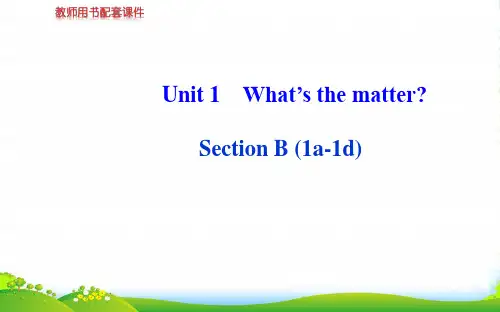
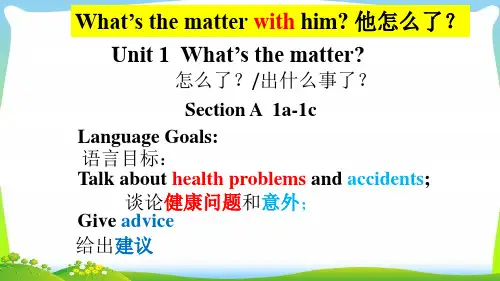

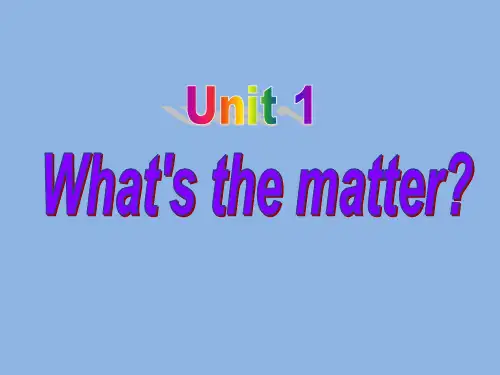

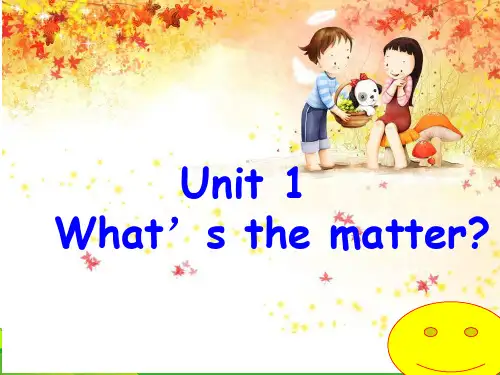
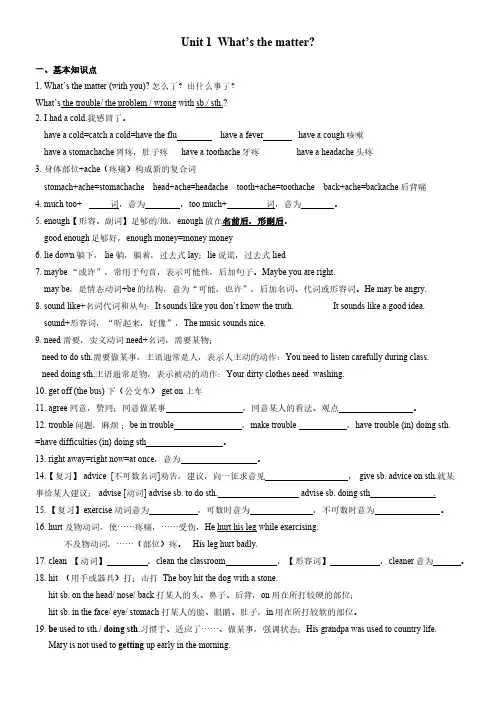
Unit 1 What’s the matter?一、基本知识点1. What’s the matter (with you)? 怎么了?出什么事了?What’s the trouble/ the problem / wrong with sb./ sth.?2. I had a cold.我感冒了。
have a cold=catch a cold=have the flu have a fever have a cough咳嗽have a stomachache胃疼,肚子疼 have a toothache牙疼 have a headache头疼3. 身体部位+ache(疼痛)构成新的复合词stomach+ache=stomachache head+ache=headache tooth+ache=toothache back+ache=backache后背痛4. much too+ 词,意为,too much+ 词,意为。
5. enough【形容、副词】足够的/地,enough放在名前后,形副后。
good enough足够好,enough money=money money6. lie down躺下, lie 躺,躺着,过去式lay;lie说谎,过去式lied7. maybe “或许”,常用于句首,表示可能性,后加句子。
Maybe you are right.may be,是情态动词+be的结构,意为“可能,也许”,后加名词、代词或形容词。
He may be angry.8. sound like+名词代词和从句:It sounds like you don’t know the truth. It sounds like a good idea.sound+形容词,“听起来,好像”,The music sounds nice.9. need 需要,实义动词need+名词,需要某物;need to do sth.需要做某事,主语通常是人,表示人主动的动作:You need to listen carefully during class.need doing sth.主语通常是物,表示被动的动作:Your dirty clothes need washing.10. get off (the bus) 下(公交车) get on 上车11. agree 同意,赞同;同意做某事,同意某人的看法、观点。

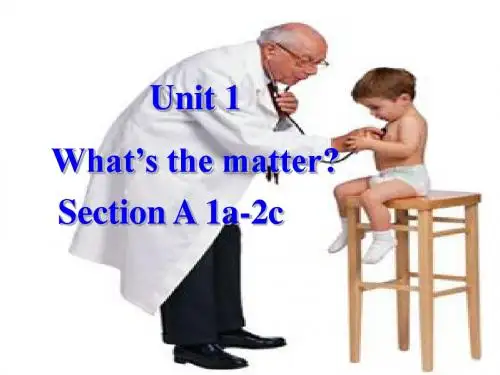
新人教版初二下册英语知识点归纳:Unit-1-What’s-the-matter新人教版初二下册英语知识点归纳:Unit-1-What’s-the-matter一.询问某人患了何种疾病或遇到什么麻烦时,常用以下句型:1.What’s the matter (with sb)?2. What’s the trouble / problem(with sb)?3.What’s wrong (with sb)? 你怎么了?4. What’s one’s trouble / problem ?5.What’s up ?6. What happened to sb ?7.Are you OK ? 8. Is there anything wrong with sb ?二.表达身体不适或疼痛时,常用以下结构:1.Sb + have /has + a / an + 疾病名称:have a cold(患感冒)/ fever / cough / temperature注:have a cold相当于get a cold/catch a cold/have got a cold;have a bad cold(患重感冒);have a heart problem 有心脏病2.Sb + have/ has a sore +身体部位:have a sore throat / back3.Sb + have / has+ a+ 身体部位+ache(构成疾病名词)have a toothache /headache / stomachache / earache /backache4.Sb + hurt(s) +身体部位/ oneself ; He hurt his leg .或身体部位+ hurts ; My head hurts badly .5.There is something wrong with one’s +身体部位。
人教版八年级英语下册u n i t1-w h a t's-t h e-m a t t e r-1a-1c
说课稿
尊敬的各位领导,评委老师:
大家下午好!今天我说课的内容是PEP八年级英语下册 Unit1what’s the matter?Part A( 1a-1c )部分。
下面我将从教材、学情、教法学法、教学过程和简要的板书设计及反思这六个方面展开我的说课。
一、说教材
1、教材的内容和地位
(1)教材是以“What’s the matter?为中心话题,学习谈论健康状况及如何针对身体不适问题提出建议,并倡导人们养成健康饮食及良好的生活习惯。
教育学生注意饮食习惯,关心他人。
在学习中,学生通过对身体不适的描述及建议,促进学生之间和师生之间的情感交流,增进情谊。
(2)本节是本单元的重点内容,主要学习人体各个部位名称及询问对方的身体状况,使学生学会关心他人。
2、新课标要求
新课程标准明确指出要发展学生综合运用语言的能力,培养学生的交际能力。
3、教学目标
根据教学大纲和学生的实际情况,我制定如下教学目标:
(1).知识目标:
A.识记人体各个部位的名称及如何谈论身体健康状况
B.运用”What’s the matter…?”“I have/get …”句型在日常生活中进行对话
(2).能力目标:
培养学生能运用所学语言简单的描述自己的健康状况及如何询问对方的身体健康状况。
提高学生的听、说、读综合能力。
(3)情感、态度和价值观
教育学生要学会关心他人,通过询问他人的健康情况并能给予帮助,增进人与人之间的感情。
让学生感受到学英语最主要是为了在现实生活中进行交流,而不是单纯的为了英语课和应付考试而学习。
4、教学重难点
根据教学大纲的要求,及本课在教材的地位及作用。
我确定以下重、难点:
重点:学习人体各个部位的名称及如何询问和回答身体的健康状况。
难点:有“What’s the matter?/ What’s wrong?”“I have/get a sore throat…”句型在实际生活中的应用。
二、说学情
八年级的学生对英语已经有一定的基础,但对于乡镇中学的学生来说,大部分学生学习英语的兴趣不是很浓,在学习中他们更喜欢从游戏或活动中学习。
针对这一情况,我在课堂上创造外语语言氛围,激发学生学习英语的兴趣;让学生在参与英语各项活动时,能够更好地掌握知识;同时通过对话来进行训练,巩固所学的知识。
让学生在乐中学,轻松地掌握所学知识。
三、说教法学法
作为一个引导者、组织者,我遵循新课程“学生是学习的主人,一切的教学活动设计在以学生为本”的教学理念,坚持“为学生的发展,必须培养学生的自主性、能动性、独立性和创造性”的教学原则。
课堂上我采用了多媒体、图片、和肢体动作来辅助教学,增加了直观性、活跃性和趣味性。
通过任务型教学法,,图片展示法等去引导学生学习。
学生通过在参与各种活动中学习知识。
学生在轻松的气氛里掌握知识,达到最佳的教学效果。
四、说教学过程
Step 1 Warming-up
(设计意图:让同学跟着视频音乐和里面的人物做warming-up活动,通过全方位的运动,全感官的放松,为学生创造轻松愉快的学习气氛,激发学生的好奇心,为学习新课拉开了完美的序幕。
让学生很快融入到英语学习的氛围中,同时为下面引出身体各部位名称的教学作铺垫。
)
Step 2 Word study
(设计意图:用明星的图片激发学生的兴趣,用图片来教学新的单词,直观、形象生动,有利于单词的巩固记忆。
)
Step 3 Practice
检查学生对身体部位单词的掌握情况。
Step 4 Presentation and practice
(设计意图:以happy这个单词自然地引出the wo man who’s not happy because she has a cold.为下面引出其他人的种种不适做铺垫。
)
What’s the matter? He/She has a headache/ toothache /stomachache /a sore back/ a sore throat.
(设计意图:用形象生动的图片来引出本课要掌握的句型,有利于学生对新知识的掌握。
)
3. Grammar focus.
呈现完新句型后,我把重点知识点予以整合。
(设计意图:对重难点知识提炼与整合,让学生更好的对重点知识系统性的记忆,加深印象。
)
4. Practice(对话练习)
(设计意图:以对话的形式来操练句型,巩固新句型的使用。
从第三人称过渡到第一人称,对学生来说是简单了。
)
Step 5 listening
听之前分析内容
(设计意图:作好听力前的铺垫对于学生提高正确率非常重要,所以在听前对图片和任务的分析很有必要,为学生接下来的听力任务打下了基础。
)
在整体感知后,我把听力截成五个对话部分,让学生用填空的方式完成表格,从而为下面的1c对话练习做好铺垫。
Step 6 Speaking
结合1b的表格再让学生仿照1c的例句造句,让更多的学生有表达的机会。
Step 7 Exercises
1.Fill the blanks
2.look and say
3.Translate
有词到短语再到句子分层练习,让知识递进,有层次性,学生更容易接受。
Step 8 Summary
1.Ask students to sum up the parts of a body and the names of illness.
2.询问健康问题的句型有:What’s the matter with…?
3.回答健康问题可用:I have a…She has a …
五、说板书设计
Unit 1 What’s the matter?
Period 1 Section A (1a-1c)
What’s the matter with sb.?
cold foot(feet)
sore back back
sore throat throat
sb. have/has a
head ache head
Stomach ache stomach
Tooth ache tooth(teeth)
板书设计以简单明了为主,把重点知识呈现在黑板上,让学生一目了然,同时我注重了单词与短语之间的相互呼应,更有对比性。
六、说教学反思
教学亮点:我注重培养了学生的朗读能力和英语交流的能力,并通过听、说、做等活动激发学生的学习兴趣,鼓励他们大胆说,逐步帮助他们养成良好的学习习惯,发展自主学习的能力,为下一步学习打下了基础。
教学不足:情境课堂的开展,更多适用于相对积极踊跃的孩子们,参与的积极性高,效果显著。
相反,对于性格内向且不爱发言、表达表演能力相对薄弱的孩子们来说,在活动方法上应继续有所改进。